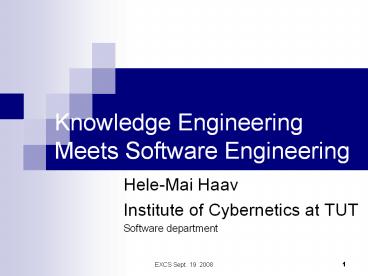Knowledge Engineering Meets Software Engineering PowerPoint PPT Presentation
1 / 16
Title: Knowledge Engineering Meets Software Engineering
1
Knowledge Engineering Meets Software Engineering
- Hele-Mai Haav
- Institute of Cybernetics at TUT
- Software department
2
Outline
Knowledge-based systems Ontologies and their
applications (Semantic) web services
SE
KE
3
Knowledge-based Systems...
- ...for engineering computations (also
knowledge-based SE) - Historical field of activities at software
department of IoC - Systems with structural synthesis of programs
capturing domain knowledge in form of
computational models PRIZ, ExpertPriz, NUT, etc
(E. Tyugu et al) - Current system CoCoViLa supports visual
specification of domain knowledge still using
structural synthesis of programs (E. Tyugu, M.
Harf, P. Grigorenko, R. Maigre, A. Ojamaa )
4
Ontologies and their Applications
- Ontology a shared conceptualization of a domain
that is commonly agreed to by all parties, a
specification of a conceptualization (Gruber
1993) - Ontology means to facilitate knowledge reuse by
different applications, software systems and
human resources. - Ontologies are highly expressive knowledge models
? increase expressiveness and intelligence of a
system
5
Ontologies and their ApplicationsOntology
Learning
- Ontology learning using Formal Concept Analysis
(FCA) (H-M. Haav) - Combining FCA and Horn logic for ontology
extraction and representation (H-M. Haav) - Learning user browsing behavior ontology for
recommender systems. - The knowledge acquired from users browsing
behavior is used for learning profile ontology
and formulating explicit user profiles in OWL-DL
for recommender systems. The method exploits the
automated reasoning capabilities provided by
OWL-DL in order to automatically classify user
profiles. (H-M. Haav, A. Kalja, T. Robal) - Ontology learning from relational databases (I.
Astrova, A. Kalja)
6
General schema of ontology learning using FCA
Domain specific texts or data
NLP based context extraction
Set of rules describing initial ontology
FCA and reduction
Concept lattice based ontology expression
Transformations
Formal Context
More rules and facts
automatic
Complete set of rules and facts representing
ontology
Inference
Expert manually
7
The process of user profile learning method
8
Ontologies and their Applications Ontology
Applications
- Smart ontology-based spatial data retrieval
- Partners IoC (H-M. Haav), companies Regio, Girf
- new project 2008-2009, partially funded by
Enterprise Estonia via ELIKO Competence Center in
Electronics-, Info- and Communication
Technologies - Semantic interoperability of large scale IS The
Estonian public sectors case study (H-M. Haav,
A. Kalja, P. Küngas, M.Luts) - Automatic transformation of OWL ontologies to
relational databases (SQL) and storing them in
relational databases (I. Astrova, A. Kalja)
9
Semantic interoperability architecture for state
information system in Estonia
10
Modularity and layering of ontologies component
in interoperability architecture
11
(Sem)web services
- Composition of web services using structural
synthesis of programs and visual specifications
(the CoCoViLa system) (E. Tyugu, P. Grigorenko,
R. Maigre) - Web service composition using FOL theorem prover
RqlGandalf. - RQL (Rule-based Systems for Creation of Web
Services) project partially funded by Enterprise
Estonia, 2004-2005. - Partners Institute of Computer Science of TUT,
Cell Networks, Sampo Assets Management). - T. Tammet, H-M. Haav, M. Kääramees, V. Kadarpik,
K. Kindel - Annotation of web services using OWL ontologies
and SAWSDL for support of semantic
interoperability of state IS (H.-M. Haav, A.
Kalja, P. Küngas, M. Luts)
12
Web service composition with CoCoViLa
- Automatic service composition tool has been
developed in software development environment
CoCoViLa that supports automatic synthesis of
programs and generates Java code from visual and
textual model specifications - User can define desired complex service that is
synthesize automatically (if it is possible to
construct the service). BPEL and WSDL
descriptions of the complex service are then
generated from Java code. - Tool has been tested on federated governmental
information system.
13
Web service composition in RQL
A goal of the system is to automatically find a
plan for service composition as an answer to the
user request. The result of program synthesis is
as a Python program corresponding to the required
composite service.
14
RQL
- Provides a new conceptual and technological
framework for using a rule language and a rule
engine for capturing application semantics in
modern web-based systems. - The approach enables to deal with two aspects of
semantics in web-based systems business rules
and web service composition logic.
15
Future plans
- SE 2.0
- Domain centred problem solving
- Domain semantics is the key to deal with next
generation technologies
Dillon T. S, Chang E., Wongthongtham P.,
"Ontology-Based Software Engineering- Software
Engineering 2.0," aswec, pp. 13-23, 19th
Australian Conference on Software Engineering
(aswec 2008), 2008
16
Ontology-based SE
- Use of ontologies in different aspects of
software engineering - Ontology Based Multi-Site Software Development
- Ontology Mediated Information Access
- Ontology and Semantic Web Services
- Ontology based Multi Agent Systems

